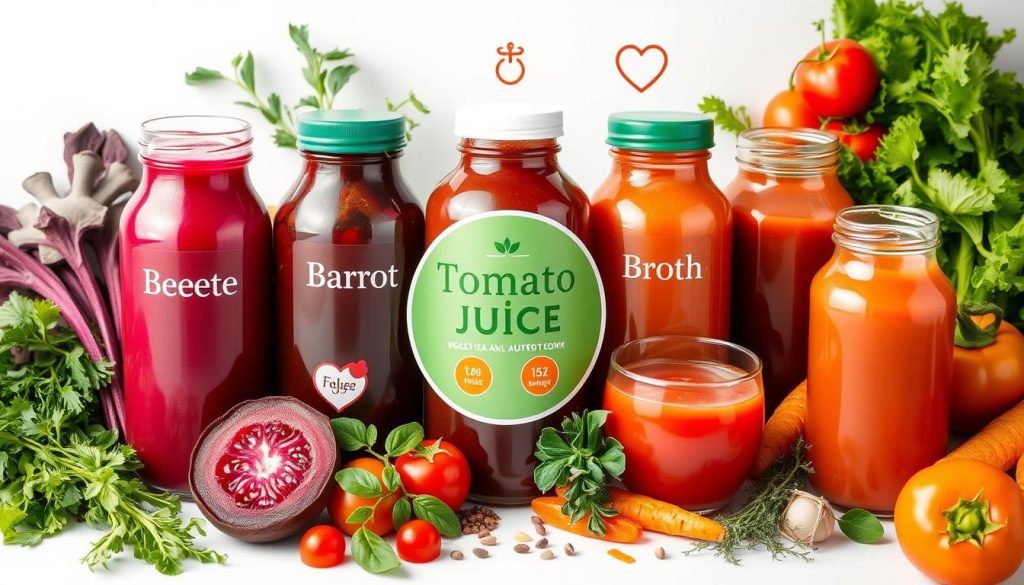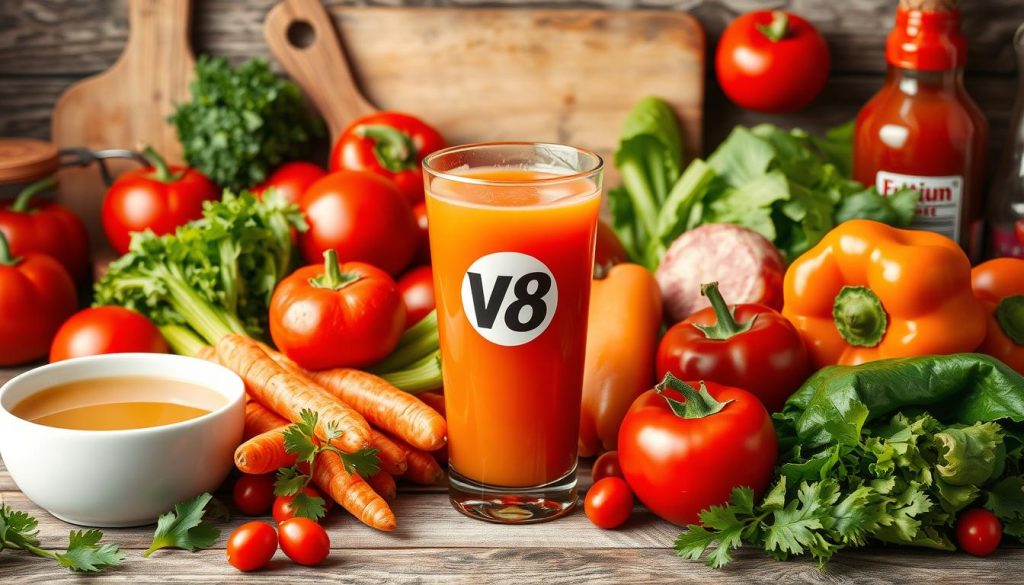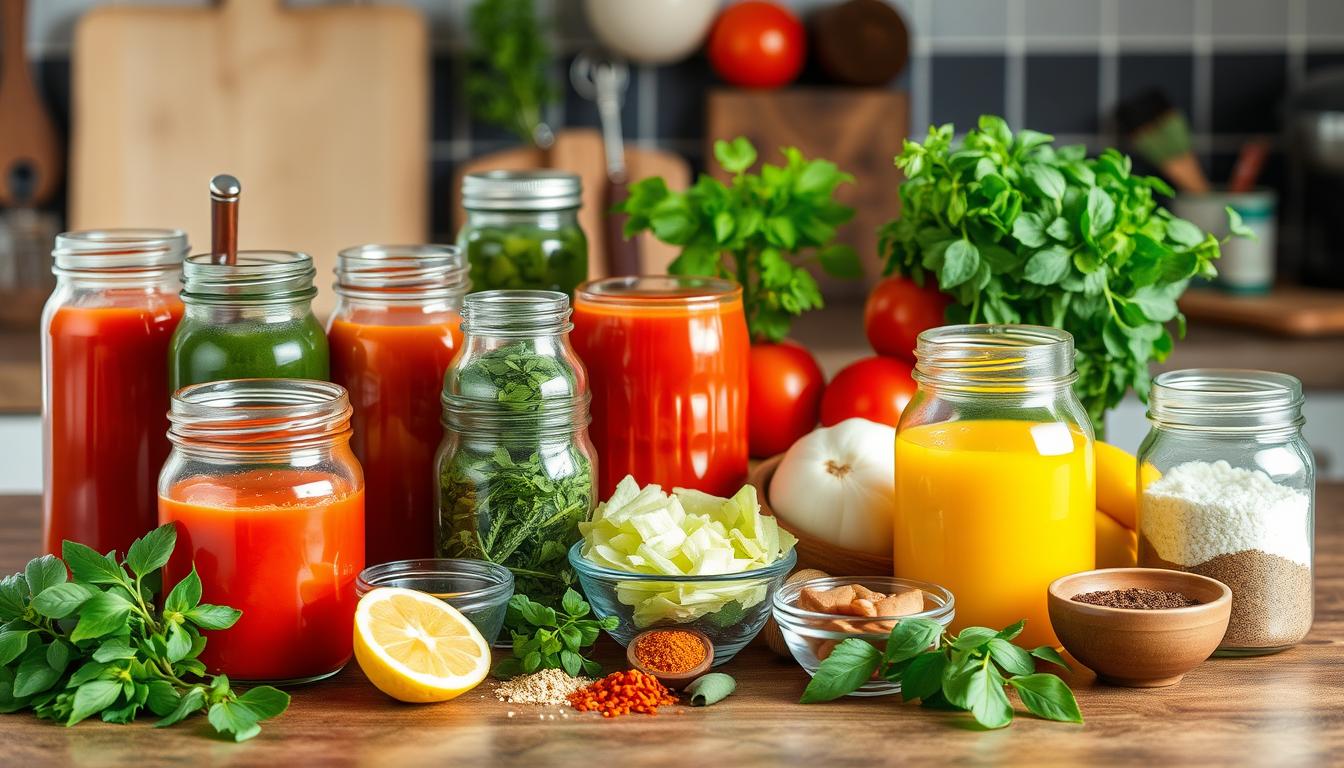Tomato juice is a favorite in many recipes, but sometimes you might want a different option. Maybe you don’t like the taste, or you’re watching your sodium intake. Or perhaps you just can’t find tomato juice in your pantry.
Knowing how to swap out tomato juice can make a big difference. It can add new flavors to your dishes and keep your drinks healthy. This guide will show you how to make tasty meals and drinks without tomato juice.
Understanding Tomato Juice and Its Uses
Tomato juice is a versatile ingredient loved for its taste and health perks. It’s made from crushed tomatoes, packed with vitamins and minerals. Its balanced flavor makes it great for cooking and drinks.
What is Tomato Juice?
Tomato juice is a favorite drink made from fresh tomatoes. It has about 41 calories, 2 grams of protein, and 2 grams of fiber. It’s also rich in vitamins, with 22% of Vitamin A and 74% of Vitamin C.
It also has 22 mg of lycopene, an antioxidant that’s good for the heart and may lower cancer risk.
Common Applications in Cooking and Beverages
In the kitchen, tomato juice is key in many recipes. Its acidity and sweetness are perfect for soups, sauces, and stews. It’s also great for adding tomato flavor to dishes that need more liquid.
Plus, it’s a must-have in popular cocktails, like the Bloody Mary.
Here’s a quick overview of tomato juice’s versatility:
| Application Type | Example Dishes | Nutritional Benefits |
|---|---|---|
| Cooking Applications | Soups, Sauces, Stews | Rich in vitamins and boosts flavor |
| Beverage Applications | Bloody Mary, Tomato-based smoothies | High in lycopene and vitamins |
Using whole peeled or crushed tomatoes can make your meals taste better and be more nutritious. These options need less processing, so you get more of the tomato’s goodness.
Tomato Juice Substitute Guide for Cooking & Drinks
There are many reasons to look for tomato juice substitutes. You might be watching your sodium intake or have dietary restrictions. Or maybe you just want to avoid additives in tomato juice that could cause health problems. Knowing these reasons can help you make better choices in the kitchen.
Why Substitute Tomato Juice?
There are several reasons to swap out tomato juice. Some people prefer low sodium options because store-bought juices often have too much salt. Others might not like the additives in tomato juice. Choosing alternatives can help you stick to your diet while still enjoying great flavors.
Health Considerations: Low Sodium and Additives
Tomato juice can have additives like onion and garlic powder. These might not be good for everyone, especially those with health issues. Making your own tomato juice with simple ingredients can avoid these additives. It also leads to fresher tastes. Here’s a table showing different substitutes and how to dilute them:
| Substitute | Dilution Ratio | Serving Yield |
|---|---|---|
| Tomato Sauce | 1 part tomato sauce to 1 part water | Varies |
| Tomato Paste | 1 part tomato paste to 4 parts water | Varies |
| Tomato Soup (Concentrate) | 1 part soup to 3 parts water | Varies |
| Tomato Soup (Ready-to-Heat) | 1 part soup to 2 parts water | Varies |
| Ketchup | 1 part ketchup to 8 parts water | Varies |

These substitutes meet your health needs and still taste great. They let you enjoy your recipes without sacrificing taste or nutrition.
Easy Substitutes You Can Make at Home
Need a quick tomato juice substitute? Making simple homemade substitutes can be a lifesaver. Use tomato sauce, tomato paste, or canned tomatoes for tasty alternatives. These options fit right into your cooking without needing a store run.
Tomato Sauce as a Quick Replacement
Mix tomato sauce with water for a reliable substitute. Use equal parts to get a taste and texture close to tomato juice. This mix works great in sauces and soups, keeping flavors rich.
Using Tomato Paste for Versatile Solutions
Tomato paste is great for a quick fix. Mix one part paste with four parts water for a thick blend. It’s perfect for stews and casseroles, adding depth to your dishes. You can easily adjust the flavor with tomato paste.
Canned Tomatoes: A Quick Fix
Canned tomatoes are a top choice for a quick fix. Blend them to get a smooth consistency like tomato juice. They’re great for sauces and salsas, adding a rich flavor. Plus, they’re often free from artificial additives, making meals healthier.
Alternative Store-Bought Options
Looking for store-bought alternatives can help you find the right flavor for your dish. Options like V8 juice, tomato soup, and ketchup have unique benefits. Each alternative product meets different cooking needs.
Consider V8 Juice for a Flavorful Swap
V8 juice is not just a mix of vegetables. It also has a strong flavor that can boost your dishes. It’s perfect for soups and marinades. The mix of vegetables gives it a unique taste and adds nutrients.
A 12-ounce bottle of V8 juice is a great addition to your pantry. It brings taste and health benefits to your cooking.
Using Tomato Soup in Recipes
Tomato soup is more than just a meal. It’s a great base for many recipes. It adds moisture and flavor, but you might need to adjust its sweetness.
Thicker soups can be thinned by simmering. This makes it very versatile in cooking. It’s a great alternative to use.
Ketchup or Catsup: A Last Resort
Ketchup can be a quick fix when you’re short on time. It’s sweet, but works well in some recipes. To use it, mix it with water to balance its sweetness.
Remember, ketchup won’t perfectly replace tomato juice. But it can add a unique flavor to your dish.

| Substitute | Ratio | Best Uses |
|---|---|---|
| V8 Juice | 1:1 | Soups, Marinades |
| Tomato Soup | 1:1 (adjust sweetness) | Casseroles, Pasta Sauces |
| Ketchup | 1:1 (dilute with water) | Chili, Barbecue Sauce |
Vegetable-Based Substitutes
Looking for a tomato juice replacement? Vegetable-based alternatives offer a variety of flavors without the acidity. They add a wholesome taste and versatility to your cooking and drinks.
Vegetable Broth: Flavor without Tomatoes
Vegetable broth is a great liquid base for dishes. It has rich, savory flavors. It’s low in calories and full of nutrients, making it perfect for soups, sauces, and stews.
Its layered taste adds depth, making your dish enjoyable and satisfying.
Juicing Other Vegetables: A Creative Twist
Using a juicer? Try juicing bell peppers, carrots, or cucumbers. They add natural sweetness and color to your recipes. Juicing vegetables opens up endless creative possibilities.
Blend different vegetables for a unique flavor. This way, you can achieve a balanced taste in your drinks or soups.
Combining Sweetness and Acidity with Other Ingredients
For a balanced flavor, mix in sweet and acidic elements. Lemon juice, vinegar, or honey can enhance your dish. Aim for a harmonious flavor balance to make your creations delightful.
| Substitute | Flavor Profile | Best Uses |
|---|---|---|
| Vegetable Broth | Savory, Rich | Soups, Stews, Sauces |
| Juiced Bell Peppers | Sweet, Mild | Drinks, Soups, Sauces |
| Carrot Juice | Sweet, Earthy | Soups, Dressings, Marinades |
| Lemon Juice | Tart, Bright | Dips, Dressings, Balancing Flavors |
Tips for Adjusting Your Recipes
When you swap tomato juice in your cooking, making the right adjustments is key. This ensures your dish stays tasty. Knowing how your substitute affects flavor and texture is important.
Flavor Adjustments: Seasoning and Spicing
When using substitutes, you might need to tweak your seasoning. For example, using tomato sauce instead of paste means adding more seasoning. A good rule of thumb is to use three times as much seasoning as the sauce.
If you’re swapping ketchup for paste, a 1:1 ratio works well. This keeps the flavor rich and deep.
Texture Considerations when Using Substitutes
Texture is also a big deal when changing ingredients. Some substitutes can change how your dish feels. For instance, canned tomatoes can make your dish too thin.
To fix this, use three tablespoons of canned tomatoes for every tablespoon of paste. You might also need to adjust the liquid or add thickeners. Always taste as you go to get the texture just right.
Conclusion
Exploring the world of cooking and drinks can be exciting. Having a summary of substitutes for tomato juice is very useful. You can make your own like tomato sauce or use store-bought options. This way, you can keep your dishes tasty.
Choosing the right substitutes can make your food even better. Try using vegetable broth for a lighter taste or add fresh tomatoes. This can change soups and sauces in amazing ways. Remember, following the cooking tips from this guide can lead to tasty, healthier meals.
Being able to swap out tomato juice in your recipes gives you freedom. Keep these alternatives in mind and get creative. Make each dish your own, ensuring it’s safe and delicious.
Source Links
- https://prepareandnourish.com/how-to-make-tomato-juice-from-tomato-paste/
- https://www.alphafoodie.com/how-to-make-tomato-juice/
- https://nchfp.uga.edu/how/can/how-do-i-can-tomatoes/tomato-juice/
- https://www.healthline.com/nutrition/tomato-juice
- https://www.allrecipes.com/article/types-of-canned-tomatoes/
- https://www.thespruceeats.com/best-tomato-juice-substitutes-4155665
- https://www.wyseguide.com/tomato-juice/
- https://www.simplyrecipes.com/7_types_of_canned_tomatoes_and_how_to_use_and_swap_them/
- https://www.realsimple.com/substitute-for-tomato-paste-8408252
- https://www.runningtothekitchen.com/how-to-make-your-own-v8-juice/
- https://www.alsothecrumbsplease.com/tomato-sauce-substitute/
- https://www.verywellfit.com/substitues-for-tomato-sauce-5212152
- https://www.cozymeal.com/magazine/tomato-paste-substitute
- https://santokuknives.co.uk/blogs/blog/the-ultimate-guide-to-tomato-sauce-substitute-delicious-alternatives-for-your-recipes
- https://extension.missouri.edu/publications/gh1456
- https://www.yahoo.com/lifestyle/tomato-paste-pinch-15-substitutes-121706300.html
